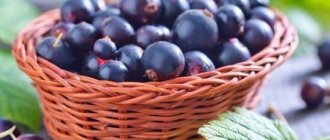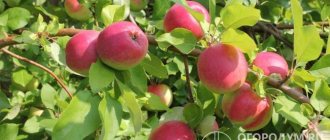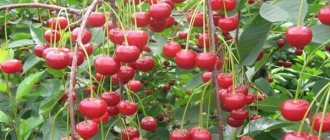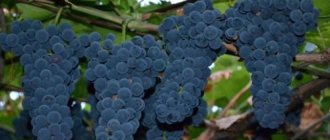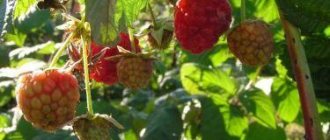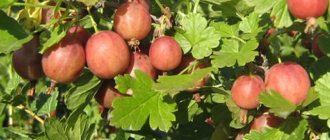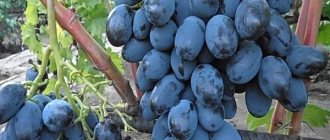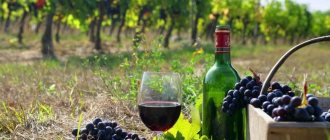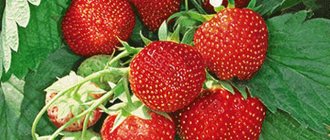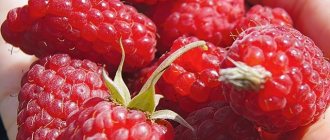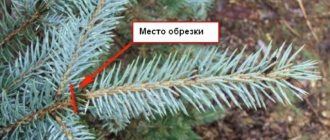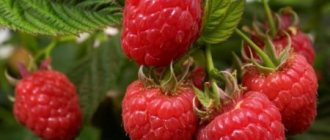Bystrinka cherry - what kind of universal purpose variety is it?
This crop was obtained by crossing the Zhukovskaya and Zolushka varieties. A characteristic feature of the plant is considered to be high frost resistance. Cherries can tolerate temperatures down to -45 degrees. Even such parameters do not provoke freezing of flower buds.
Main characteristics of culture, advantages and disadvantages
Cherry is a partially self-fertile variety. Trees do not exceed 2.5 m in height. This allows you to save a lot of space on your site. The crown is characterized by a spherical shape and straight branches. Young shoots have a smooth surface and brown bark. As the tree develops, it acquires a rough texture.
This variety of cherry is characterized by dark green foliage in the shape of an ellipse. It has a slightly wrinkled surface. The veins are clearly visible on each side of the plate.
The flowering of the crop begins at the end of May. The flowers reach 2 cm in diameter. They have 5 petals with orange stamens in the center. Flowers form umbrella inflorescences. Each of them contains 3-5 pieces.
The flowering of the crop begins in May
Already in early July it is possible to harvest. Cherry berries are oval in shape and weigh 2.5-3 g. Inside there is a seed that is easily separated from the pulp. The fruits have a sweet and sour taste. They can be used to make jam or infusions. It is also permissible to dry and freeze berries.
According to the description of the variety, Bystrinka cherry has the following advantages:
- high productivity;
- compact dimensions of the tree;
- excellent taste;
- low maintenance requirements;
- precociousness;
- good transportability of fruits.
The key disadvantage of the culture is considered to be susceptibility to fungi. The plant may suffer from moniliosis and coccomycosis.
Cherry variety ripening period, yield indicators
The plant is characterized by an early period of ripening. The first flowers appear in mid-May. At the same time, the harvest can be harvested at the end of July. The timing of fruiting is affected by the age of the seedling. The first fruits can be obtained 3-4 years after planting.
Note! Although the plant is considered self-fertile, it will be possible to obtain a high yield only if there are pollinators nearby. In this case, it is possible to collect up to 80 centners of berries from 1 hectare.
Main characteristics of the variety
This cherry variety is self-fertile, so it does not need additional pollinators, but if Turgenevskaya or Caucasian cherries are planted nearby, the ripening time is reduced, and harvesting occurs at the beginning of July.
The Bystrinka variety is characterized by increased resistance to frost and drought. It is capable of bearing fruit in the temperature range from -35°C to 45°C.
The ripening time for such cherries without pollinating neighbors is average, so the harvest occurs at the end of July. It can be collected until mid-August, because the fruits are protected from cracking and rotting. The tree begins to bear fruit 4 years after planting.
Description of the bush
Bystrinka cherry bushes are small. The maximum height is 3 m. The tree reaches it in the first year of growth in a permanent place. All other years the culture grows in breadth.
The crown is oval in shape. The branches are arranged vertically. 10 years after planting, the crown takes on a weeping appearance - the branches look down.
The inflorescences are presented in large numbers with white flowers. They consist of 5 flowers, which contain 20 stamens and 20 pistils. Their maximum dimensions are 6 mm. The shoots are large - up to 45 cm. The rich brown bark begins to peel off over time.
Among the characteristics of the sheet plate, the following features are noted:
- oval oblong shape;
- color - dark green;
- the upper part is glossy with a large amount of waxy coating;
- the lower part is matte, rough.
Features of the fetus
The description of the Bystrinka cherry indicates that the fruits are characterized by the following features:
- round berries;
- the average weight of the fetus is 3 g;
- the color is dark red: when fully ripe, it acquires a burgundy hue, with reflections of burgundy;
- The peel is dense and protects the fruit from cracking.
The description of the pulp indicates juiciness and fibrous structure. The taste is dominated by sweetness, as the sugar level is 20%. At the initial stages of ripening, the taste contains acid, which disappears over time. Berries of this variety are used both fresh and canned (jams, preserves, compotes, etc.).
The crown of the tree of this cherry variety is not dense, its shape resembles a balloon, slightly raised and oval. The branches are brown, closer to brown, straight, medium length. Medium-sized buds are significantly removed from the shoot. The leaves are teardrop-shaped, with a smoothly pointed tip and serrated edges. The structure of the leaf is matte, slightly wrinkled, the plate is slightly curved inward, and is of the usual rich green color.
Bell-shaped inflorescences are collected from four white flowers, the petals of which are tightly in contact. The diameter of the corolla is about 22 cm. Bystrinka blooms at the end of spring; the ovaries are formed, as a rule, on annual shoots and bouquet branches. The fruits are quite large, weighing more than four grams.
It is important to make sure that the tree feels comfortable in the climate zone chosen for growth. Timely prevention of diseases and pests, as well as regular fertilizing will help you get an excellent harvest.
Growing technique, planting and subsequent care
In order for a culture to grow and develop normally, it needs to be provided with complete and high-quality care. Proper carrying out of planting work is of no small importance.
The plant is characterized by high productivity
Optimal soil types
It is recommended to plant cherries in loamy or sandy loam soil. It should be non-acidic. The plant is suitable for an area that is well warmed by the sun and has protection from drafts.
Reproduction methods
Most often, cherries are propagated by classical budding. It is also permissible to carry out cuttings. In this case, it will be possible to preserve the varietal qualities of the crop.
Pruning and crown formation
Bystrinka cherry is a low-growing variety that requires systematic pruning. The procedure must be performed after the snow has melted. This must be done before the buds open.
It is necessary to form a tree in the first year after planting. Annual seedlings need to be pruned to the branching area. In this case, the cut must be made straight, positioning it 5 cm above the kidney.
For seedlings 2 years old, up to 8 skeletal branches must be left during pruning. After which they need to be shortened by a third so that there is no excess growth. Subsequently, it is necessary to get rid of weak or damaged branches.
Important! After pruning is completed, all damaged areas must be treated with garden varnish. Otherwise, there is a risk of weakening the tree’s immunity.
Planting a seedling
Fruit tree seedlings are planted in autumn and spring. Bystrinka cherries planted in spring take root better and grow faster, and this also saves the seedling from freezing. Having decided to plant Bystrinka on your site, you need to find a suitable place for it and carefully select a seedling - this will become the basis for a high harvest in the future.
Selecting a location
For growing Bystrinka cherries, light loamy or sandy loam, well-drained, moderately fertile soils with a neutral or alkaline acid reaction are suitable. On acidic soils, cherries grow poorly and often die. If the soil pH in the garden is below 6.5 and horsetail, wild sorrel, and violet grow, then they need to be neutralized. This can be done with lime, adding it to the soil at the rate of 600 g per 1 square meter. m.
A place protected from drafts, well lit, located on the south or southeast side is suitable. If your garden has raised areas, these are also suitable for growing cherries. The depth of groundwater must also be taken into account. It should be below 2–2.5 m.
Selection of seedlings
When choosing a seedling, you need to pay attention to its general condition and the following characteristics:
- Condition and development of the root system - the roots must be clean, without rot or traces of fungal diseases.
- No damage or cracks on the trunk and branches - the bark should be smooth, uniform in color, without peeling or growths.
- Development and arrangement of branches - a one-year-old seedling has only a central trunk, which should be smooth and at least 1.5 cm in diameter, with well-developed growth points, and a 2-year-old - with 5-6 skeletal branches, evenly located on the trunk at an angle 35–34°.
Landing technology
The seedling is soaked for 2–4 hours in water with a growth stimulator (Kornevin, Epin, Gaupsin), and a planting hole is prepared. For cherries, it should be 60 cm deep and 50–70 cm wide. If several Bystrinka trees are planted, the distance between them should be 2.5 m.
Rules for proper landing
A wooden stake 1.3–2 m high is driven into the center of the planting hole; it will become a support for fixing the stem. A nutrient mixture with fertilizers is placed in a slide at the bottom. For it you will need:
- 1 liter of wood ash;
- 30 g superphosphate;
- 5 kg of compost;
- soil from the pit.
After this, you need to place the seedling in the hole, make sure that the roots lie evenly, and the root collar is 3-4 cm above the surface level. Fill with soil, compact the soil around the tree, water (1-2 buckets of water) and mulch with dry peat or sawdust, without covering the root collar.
Resistance to adverse factors, diseases and pests
Cherries of this variety are highly resistant to moisture deficiency and are considered undemanding to care. The tree can withstand quite severe frosts. Flower buds tolerate temperature drops down to -45 degrees.
In this case, the culture is considered susceptible to fungal infections. Most often she suffers from anthracnose, coccomycosis, and curly hair. The crop is also susceptible to hole spot and fruit rot.
Important! Diseases most often occur when the tree is weakened. With systematic prevention and fertilization, the likelihood of crop damage is minimal.
To avoid the development of pathologies, it is important to systematically remove weeds and rotten leaves around trees. Loosening the tree trunk circle is of no small importance. Flowers should be treated with Bordeaux mixture.
When disease symptoms appear, it is important to treat the crop with fungicidal preparations. To prevent attacks by aphids, cherry moths or sawflies, you should use Actofit.
Immunity
The variety has fairly good immunity, which protects the Miracle Cherry from most infections and insects. The miracle cherry is very rarely affected by diseases such as coccomycosis and moniliosis, and the tree is also very rarely affected by the cherry fly. However, there are diseases from which Duke is still not 100% protected.
- Gommoz. This disease causes a light brown sticky substance called gum to appear on the branches and trunk. This disease is caused by broken branches or severe temperature changes. To prevent the appearance of this disease, you need to prune correctly without damaging the tree, and also not to overfeed the cherry with fertilizers.
- Clusterosporiasis. The primary sign of the appearance of this disease is the formation of spotting on the leaf blades. Over time, holes with a red border appear in place of the spots. The best prevention of clusterosporiosis is crown thinning.
- Gray rot. This disease develops best in conditions of high humidity. During gray rot, gray new growths appear on the branches, and then the fruits rot. The best preventive measures are to prune in a timely manner and not to overdo it with fertilizing the tree.
- Powdery mildew. When it is very hot, a characteristic white coating appears on the leaves and branches. This leads to the fact that the leaves begin to fall off and the yield drops significantly. The best preventative measures to combat powdery mildew are timely watering and high-quality tree fertilizer.
